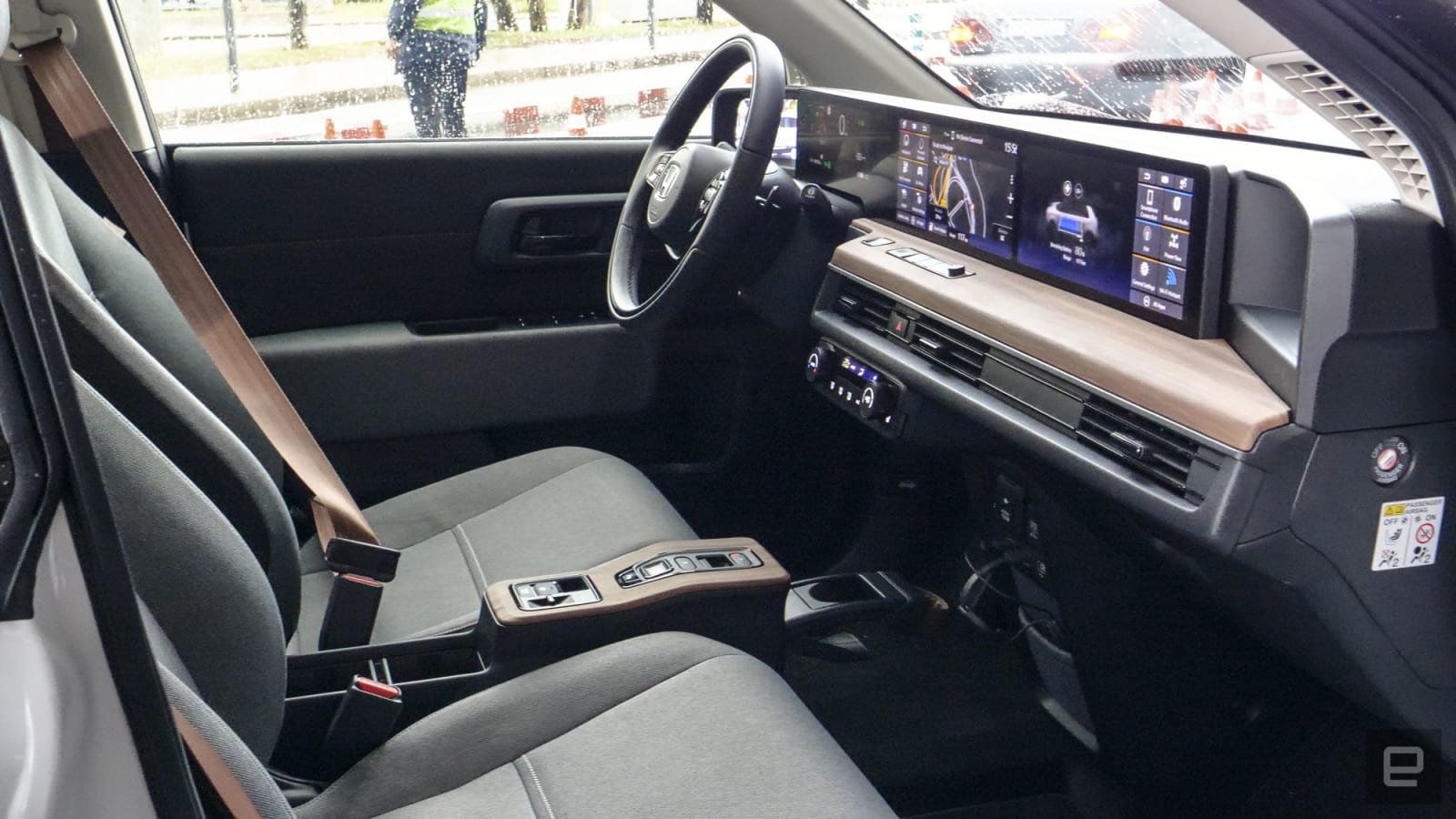Features
The E is a key car for Honda because it’s one of the first vehicles of its new “electric vision,” along with the next-generation hybrid-only Jazz (aka the Fit in the US). Honda wasn’t talking much about electric cars a few years ago, but now it plans to electrify two-thirds of its vehicles around the world by 2030. And it wants to have electric or hybrid versions of all its core European models by 2022.
Rather than competing directly with the longer-range EVs of its biggest rivals in Europe (including Renault, Nissan and Tesla), Honda decided to target the E at urban markets. While it’s competing in the same price segment as the Renault Zoe and 40 kWh Leaf, it has a smaller 35.5 kWh battery. In exchange, the E is higher-tech than all its rivals, especially when it comes to the infotainment options.
It’s also much more stylish. Production cars are often a far cry from the avant garde concepts they’re based on, so I was pleased to see that Honda stayed true to its original vision. With a shape inspired by Honda’s original Civic, the E isn’t quite as radical as the Urban concept that inspired it, but Honda has mostly kept the design that everyone fell for.
According to Takahiro Shinya, head of dynamic performance for the Honda E, the design is like that for a reason. “We needed to provide buyers with a vehicle that, at a glance, is something different,” he said. “We don’t want you to feel like you just have a different motor, but that you have bought something which is completely new, completely ‘next-generation’.”
Honda has smoothed out the body design compared to the concept and replaced the square head- and tail lights with more practical round ones. The car also sits a bit higher than the low-riding concept. Two things Honda kept were the pop-out door handles and cameras in place of rearview mirrors. Both of those things smooth out the aerodynamics and contribute to the unique look of the E.
Unlike on many EVs, the charging port is on top of the hood — for convenience and to make a statement about the E’s electric nature. You can pop the cover using the remote or your phone, and I found it to be easy to access. It does have a trunk in the rear, but it can only accommodate a few small bags — enough for grocery getting or a short weekend trip.
In the UK, the Honda E will come in two options: the E and the E Advance. Both are rear-wheel-drive, but the base model will get a 134-horsepower electric motor, while the Advance model will pack 152 horsepower. Both models will come with 232-foot-pounds of torque and weigh 3,086 pounds. That means the E has considerably more torque than Renault’s rival Zoe (180-foot-pounds) while weighing a bit less.
The most controversial part of the E is the 35.5 kilowatt-hour battery, which is smallish compared to rivals. The company figures it’s plenty big enough for urban driving and pointed out that it makes the car lighter, sportier and more efficient.
Honda will stand a great chance of selling this car if it can get the buyers inside one. With furniture fabrics and faux wood accents, the interior is bold and comfortable, making me feel more like I was in an entertainment lounge than a car. The E even has an HDMI input jack, so you can plug in a Chromecast dongle to play games or watch Netflix.
“Our interior designer wanted to create a space that’s like a living room, with a sofa and TV,” Shinya noted. “That’s to ensure that this car is not only comfortable for when you’re driving, but also when you’re charging. We wanted it to let people use it almost as a private room.”
The dashboard is completely covered by screens. Looking across, you have two 6-inch side screens for the mirrors, along with an 8.8-inch driver info display. Then there are the two 12.3-inch touchscreens in the middle, one for the driver and one for the front-seat passenger.
Again, Honda did all of this to differentiate itself from the competition. “Like, we didn’t just go with an ordinary navigation system, we tried to make sure that everything visible was new, like it came from the future,” said Shinya.
Driving
I took the Honda E on a 60-mile trip with mixed city, countryside and highway driving. Valencia was rocked by strong storms the day before, so I was able to test the EV on both dry and wet roads.
The first thing to master in a high-tech car is the infotainment systems. While I’m all about having screens in a car, I worried that I’d be overwhelmed by the wall of tech, especially since I’d only have the car for a couple of hours.
I needn’t have worried. Honda deserves a lot of credit for making the infotainment system easy. While you can operate it using the touch displays, you can control most everything with physical buttons on the steering wheel and dash. There’s even an old-school volume knob in the middle of the console.
I found it quite easy to search, create and store multi-leg trips on the E’s navigation app. On the entertainment side, it supports both Android Auto and Apple’s CarPlay, or you can use a variety of apps like Honda’s Aha radio. (Many of the apps were still not working for our test drive, however.)
As luck would have it, I was using an Android phone while my trip partner used an iPhone, so we were able to get both Android Auto and CarPlay working. Once you cue up your songs, artists or lists, it’s easy to control your tunes directly from the steering wheel without touching the displays. Overall, the Honda has better infotainment ergonomics than the Tesla’s screen-centric Model 3 or any other EV I’ve driven.







